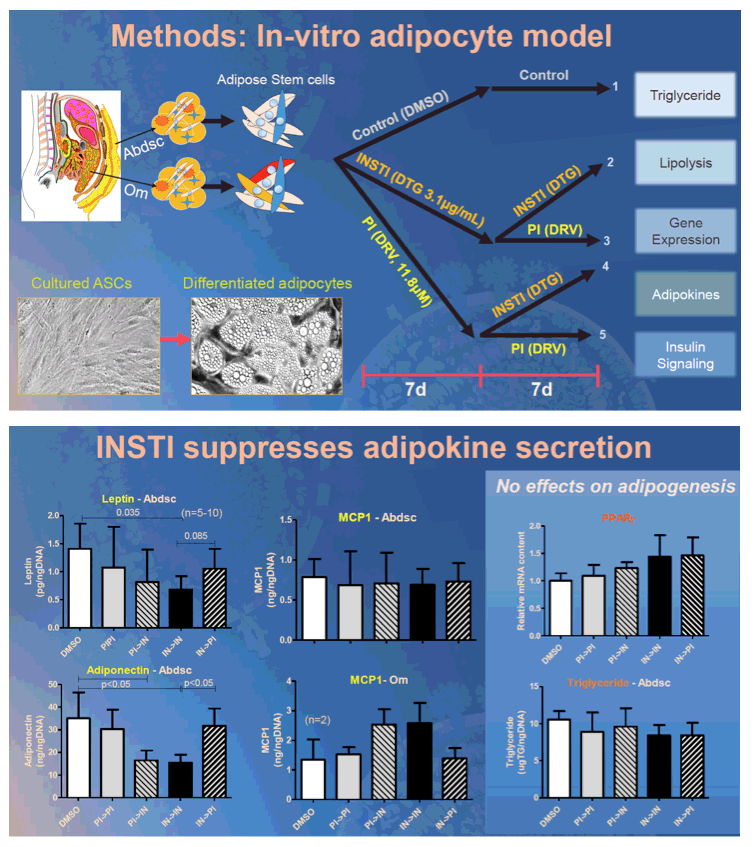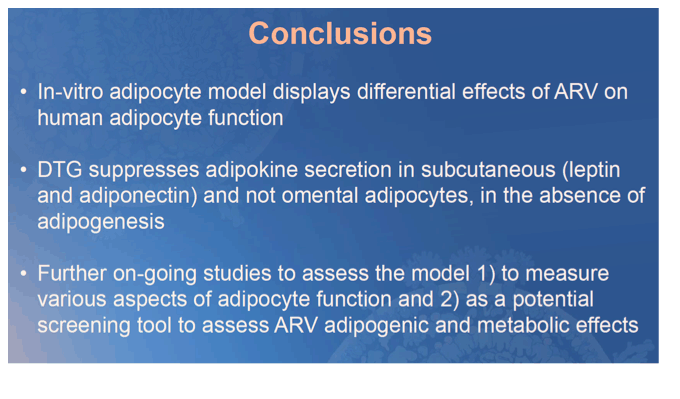 |
 |
 |
| |
IN VITRO MODEL TO ASSESS ANTIRETROVIRAL THERAPY ON ADIPOCYTE BIOLOGY
|
| |
| |
CROI 2021 March 6-10 Reported by Jules Levin
R . Taylor Pickering1, Archana Asundi1, Nina Lin1
1Boston Medical Center, Boston, MA, USA
Background: Antiretroviral therapies (ART) have diverse effects on adipose tissue biology, clinically observed through changes in weight and fat distribution with ART initiation or switch. These effects likely occur in a fat depot-specific manner, however the mechanisms remain poorly understood. Our objective was to develop an in-vitro model which allows in-depth examination of the cellular effects of specific ART regimens on adipocyte biology.
Methods: We utilized five paired human preadipocyte cultures from omental (Om) and abdominal subcutaneous (Abdsc) depots from HIV uninfected individuals to examine effects of an integrase-inhibitor (InSTI); dolutegravir (DTG), compared to a protease inhibitor; Darunavir (DRV), on adipocytes. Cells were differentiated for 7 days using an adipogenic medium. After 7 days, adipocytes were switched to a maintenance media and treated with DMSO (Control) or DTG, 3.1μg/mL for 7 days. Adipocytes were then maintained on DTG (STAY) or switched to DRV, 11.8μM, (SWITCH) until day 21. Triglyceride content was assessed by enzymatic assay and normalized to DNA content. Adipogenic and fibrotic gene expression was assessed using RT-qPCR, and adipokine secretion was determined with ELISA
Results: In both Om and Abdsc cells, exposure to DTG and DRV did not affect viability. Triglyceride accumulation did not differ between ART exposures. Adipocytes in the STAY condition had significantly increased expression of PPARγ, a late adipogenic marker, in both Om and Abdsc adipocytes (1.6 fold & 1.3 fold, p<0.05) and did not diminish with SWITCH. Expression of collagen-6 mRNA, a fibrotic marker, was increased in the STAY condition in Abdsc (1.4 fold, p<0.05) but not Om. Both leptin and adiponectin (ADCN) secretion were significantly decreased in the STAY condition (6.6pg leptin/ngDNA vs. 18.9pg; 1.0pg ADCN/ngDNA vs. 2.6pg, p<0.05), and this was partially ameliorated in the SWITCH condition (12.8ng leptin; 2.0pg ADCN, p<0.05) in Abdsc but not in Om adipocytes (Image)
Conclusion: We developed an in-vitro model using differentiated primary human adipocytes which can examine differential depot-dependent effects of specific ART on adipocyte biology. The observed decrease in leptin, a major satiety hormone, in the STAY group may help explain the increased weight gain observed in individuals taking InSTIs. This model can help define mechanisms by which ART causes adverse metabolic effects and used in pre-clinical applications to test potential, unintended adipocyte-specific effects of future ART.



|
| |
|
 |
 |
|
|